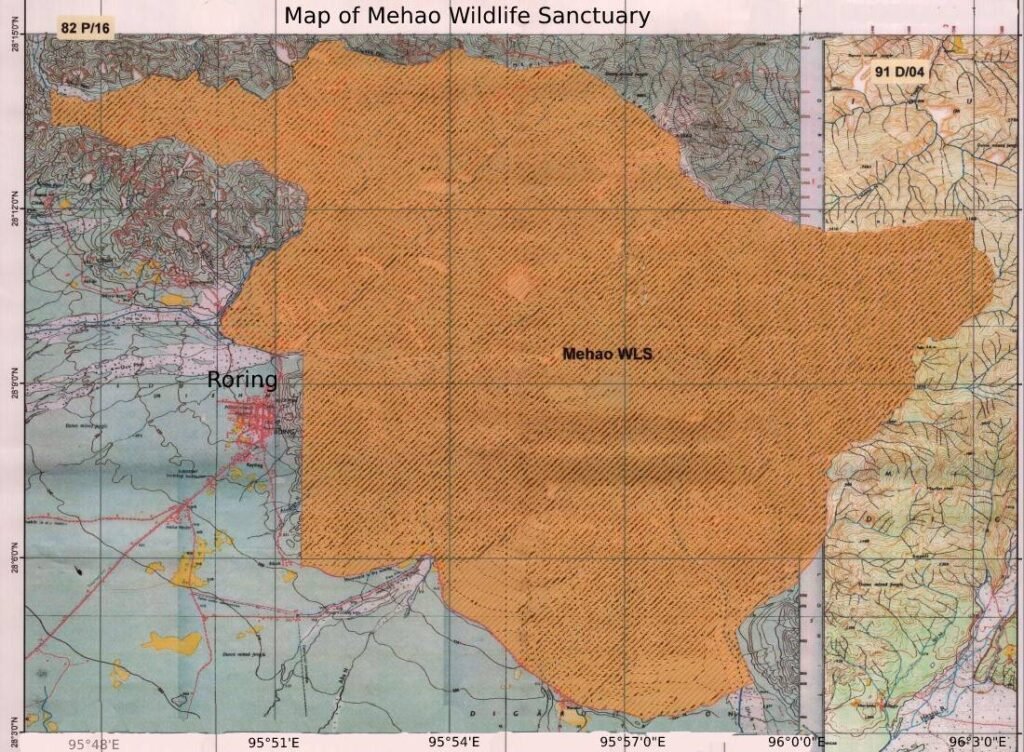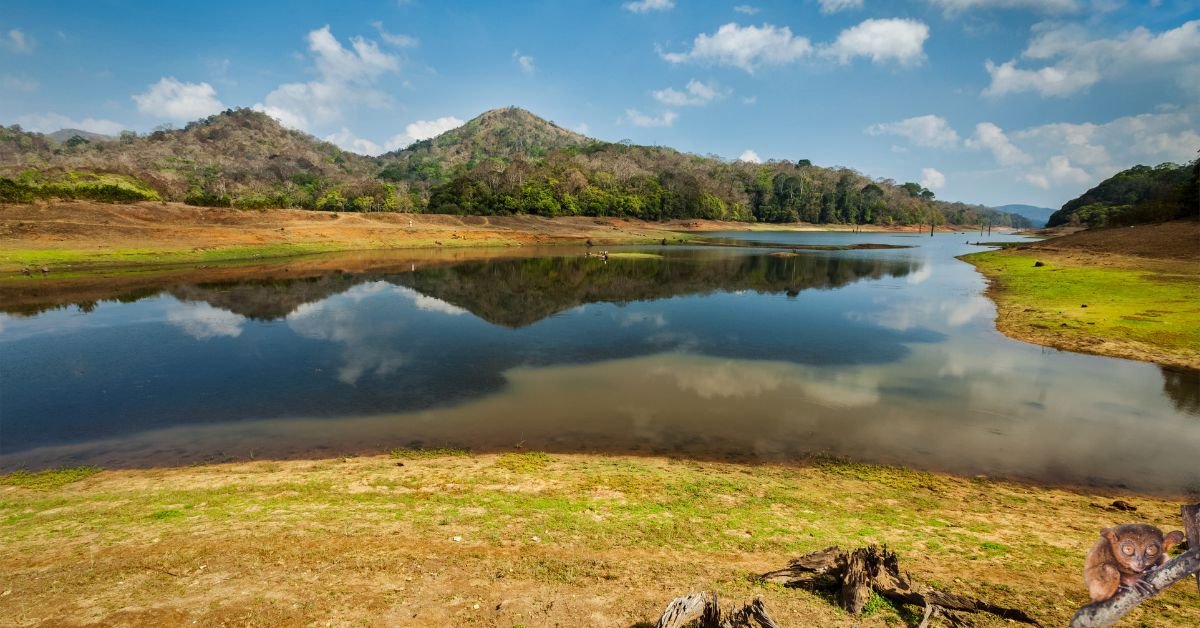Arunachal Pradesh hosts a vast network of wildlife sanctuaries that protects endangered species and rare ecosystems. These reserves range from subtropical forests to alpine meadows, offering refuge to iconic fauna like the red panda, Bengal tiger, and white-winged duck. This article explores the ecological significance, unique features, and conservation challenges of eight major sanctuaries and their role in preserving the region’s natural heritage.
Dibang Wildlife Sanctuary
Geographic and Ecological Overview
Established in 1992, Dibang Wildlife Sanctuary spans 4,150 km² in the Dibang Valley, making it Arunachal Pradesh’s largest protected area. Its elevation gradient—from 1,800 to 5,000 meters—supports subtropical broadleaf forests, temperate coniferous zones, and alpine scrub. The sanctuary is also a part of the Eastern Himalayan Endemic Bird Area.
Key Species and Conservation Significance
Dibang is a critical habitat for the Mishmi takin (Budorcas taxicolor), a goat-antelope endemic to the eastern Himalayas, and the red goral (Naemorhedus baileyi), a near-threatened species. The sanctuary also shelters red pandas (Ailurus fulgens), musk deer, and over 150 bird species, including the rare Sclater’s monal. Its remoteness has limited human interference, but climate change and potential hydropower projects threaten its ecosystems.

Visitor Experience
Accessible via the Soibari railway station (36 km away), the sanctuary offers trekking routes through valleys dotted with rhododendrons and bamboo groves. November to April is ideal for visits, with Hengda Hotel and Hilton Linzhi Resort providing nearby accommodations.
Pakhui Wildlife Sanctuary
Synergy with Project Tiger
Located in the foothills of the Himalayas, Pakhui Wildlife Sanctuary (862 km²) was integrated into the Pakke Tiger Reserve in 2002, bolstering protections for Bengal tigers (Panthera tigris tigris). The reserve’s lowland forests are part of the Terai-Duar savanna and grasslands, a globally significant ecoregion.
Flora and Fauna Highlights
Pakhui’s semi-evergreen forests host Asian elephants (Elephas maximus), gaurs (Bos gaurus), and the endangered white-winged wood duck (Asarcornis scutulata). The sanctuary is a hotspot for butterfly diversity, with species like the Kaiser-i-Hind (Teinopalpus imperialis) flitting through its canopy.
Ecotourism and Challenges
Visitors can explore the sanctuary via boat rides on the Pakke River or guided walks. However, illegal logging and poaching remain persistent threats, necessitating community-led anti-poaching initiatives.
Daying Ering Wildlife Sanctuary
Aquatic Ecosystems and Migratory Birds
Spanning 190 km² in the East Siang district, Daying Ering Wildlife Sanctuary is a mosaic of riverine islands, marshes, and grasslands. Approximately 25% of its area comprises water bodies, attracting migratory birds like Siberian cranes and bar-headed geese from Central Asia during winter.
Iconic Species
The sanctuary supports hog deer (Axis porcinus), wild buffalo (Bubalus arnee), and the elusive hispid hare (Caprolagus hispidus), one of the world’s rarest lagomorphs1. The Siang River, which encircles the sanctuary, is a lifeline for fish species like the golden mahseer (Tor putitora).
Access and Threats
Reachable only by boat from Pasighat, Daying Ering faces challenges from invasive aquatic plants and siltation. The Donyi Hango Camp Resort offers stilt-house accommodations for visitors between December and February.
Mehao Wildlife Sanctuary
Biodiversity Hotspot
Mehao Wildlife Sanctuary (281.5 km²), established in 1980, protects a range of habitats from tropical wetlands to montane forests. Its centerpiece, Mehao Lake, is a glacial wonder surrounded by primeval forests.
Flagship Species
The sanctuary is renowned for king cobras (Ophiophagus hannah), clouded leopards (Neofelis nebulosa), and the blue-naped pitta (Hydrornis nipalensis), a vibrantly colored bird. Rare amphibians like the Namdapha flying frog (Rhacophorus namdaphaensis) inhabit its streams.

Trekking and Research
A 12-km trek from Roing to Mehao Lake takes visitors through habitats shared with red pandas and hoolock gibbons. The Forest Research Institute in Itanagar collaborates with local guides to monitor wildlife populations.
Kamlang Wildlife Sanctuary
Sacred Landscapes
Established in 1974, Kamlang Wildlife Sanctuary (783 km²) in Lohit District is revered for Glow Lake, a glacial lake linked to indigenous Mishmi cosmology, and Parshuram Kund, a Hindu pilgrimage site.
Wildlife and Vegetation
Kamlang’s mixed forests shelter tigers, Asian golden cats, and the Mishmi giant flying squirrel. The sanctuary’s Cymbidium orchids and medicinal plants like Taxus wallichiana (Himalayan yew) are studied for their bioprospecting potential.
Visitor Guidelines
Accessible via Wakro, the sanctuary enforces strict no-plastic rules. The Eco-Resort Wakro provides eco-friendly stays, while October to March offers optimal wildlife sightings.
Talley Valley Wildlife Sanctuary
Unique Bioclimatic Zone
Talley Valley (337 km²), near Ziro, encompasses subtropical forests and alpine meadows above 3,000 meters. It is part of the Kaziranga-Karbi Anglong-Meghalaya biodiversity corridor.
Endangered Species
The sanctuary is a haven for the Namdapha flying squirrel (Biswamoyopterus biswasi) and Arunachal macaque (Macaca munzala), a primate species discovered in 2004. Its grasslands support the critically endangered Bengal florican (Houbaropsis bengalensis).
Tourism Infrastructure
Passa Lath Resort and Siiro Resort offer stays near Ziro. Treks through the valley reveal carnivorous plants like Nepenthes khasiana and nesting sites of the fire-tailed myzornis.
Itanagar Wildlife Sanctuary
Proximity to the Capital
Established in 1978, Itanagar Wildlife Sanctuary (140.3 km²) borders Arunachal’s capital, providing a green lung for the city. The Pam and Pachin rivers demarcate its boundaries, creating a mosaic of semi-evergreen forests and bamboo stands.
Key Biodiversity Features
The sanctuary is a stronghold for the white-winged duck (Asarcornis scutulata) and hornbills, including the great pied (Buceros bicornis) and wreathed species (Rhyticeros undulatus). Mammals like the marbled cat (Pardofelis marmorata) and slender loris (Loris lydekkerianus) thrive here.
Conservation Challenges
Encroachment by settlements and illegal logging have fragmented habitats. Local NGOs like the Arunachal Wildlife Society advocate for stricter enforcement of boundary laws.
Kane Wildlife Sanctuary
Migratory Bird Hub
Located in West Siang district, Kane Wildlife Sanctuary is lesser-known but vital for migratory birds like the black-necked crane (Grus nigricollis) and ruddy shelduck (Tadorna ferruginea). Its wetlands freeze in winter, creating unique foraging grounds.
Flora and Fauna
Kane’s oak-rhododendron forests host Asiatic wild dogs (Cuon alpinus) and Himalayan black bears (Ursus thibetanus). The sanctuary is also a botanical hotspot for Taxus contorta, a yew species with anti-cancer properties.
Travel with Taxi Nation
When exploring these sanctuaries, convenience is key. Taxi Nation offers reliable cab service in Northeast India, ensuring that your journey through these biodiverse landscapes is both comfortable and eco-friendly. Whether you’re setting out on a wildlife expedition or a cultural tour, Taxi Nation is your gateway to experiencing the true spirit of Arunachal Pradesh.
With rising challenges from climate change and development pressures, preserving these habitats is more critical than ever. Plan your next adventure with Taxi Nation and explore the natural wonders of the Eastern Himalayas, where every road leads to a new discovery. Let the sanctuaries of Arunachal Pradesh inspire your next journey into the heart of Northeast India.




